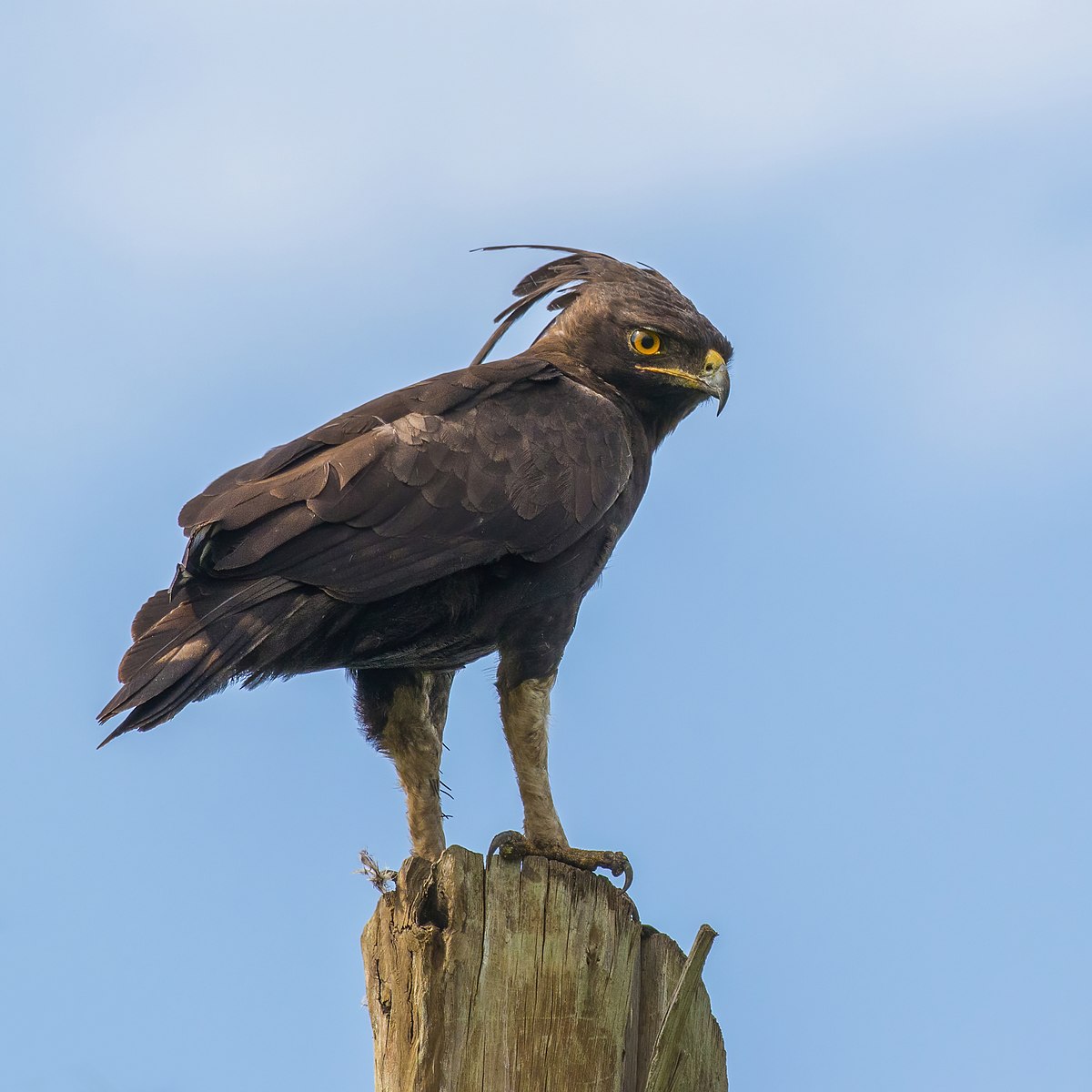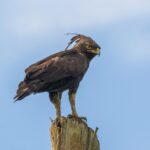Crested eagles, also known as Crested Serpent-eagles, are birds of prey that primarily hunt for snakes, particularly tree snakes. They are found in southeast Asia and prefer to spend time in primary forests, forest edges, well-wooded hills, rocky hilltops, gallery forests, savannas, mangroves, and even near villages. These eagles have a distinctive dark, short, round crest and wide wings with a white band near the end of their tail and along the trailing edge of their wings.
Breeding Season and Nesting Habits
The breeding season for crested eagles falls between the dry and wet seasons (March-April) in their natural habitat of Central America’s tropical rainforest. They do not migrate, as their natural habitat is warm enough all year round.
Crested eagles build large nests, usually in the central fork of a large tree, using sticks to create a huge platform. The female lays one egg, which is cream-colored and sometimes marked with pale brown and lilac-gray spots, and incubates it for 40-50 days while the male brings her food. When the young nestling hatches, it is covered in soft, pale down and relies on its mother to help it stay at just the right temperature. After 4 months, the young eagle will be ready to fly from the nest for the first time.
When Do Crested Eagles Fly?
 Image source: Long-crested eagle By Charles J. Sharp
Image source: Long-crested eagle By Charles J. Sharp
Crested eagles typically start flying when they are around 4 months old, after they have been cared for and nurtured by their parents in the nest. The young eagle will take its first flight from the nest, gradually learning to navigate the skies and hunt for its own food.
Factors Affecting the First Flight
Several factors can influence the timing of a crested eagle’s first flight:
-
Parental Care: The young eagle relies on its parents to provide food and maintain the right temperature in the nest. Once the parents deem the young eagle ready, they will encourage it to take its first flight.
-
Weather Conditions: Ideal weather conditions, such as calm winds and clear skies, can provide the perfect opportunity for the young eagle to take its first flight.
-
Prey Availability: As the young eagle becomes more independent, the availability of prey in the surrounding area can also play a role in the timing of its first flight.
-
Nest Location: The position and height of the nest can affect the young eagle’s confidence and ability to take its first flight.
Adaptations for Flight
Crested eagles have several adaptations that make them efficient hunters and flyers:
- Shorter Wingspan: Crested eagles have a shorter wingspan compared to other eagle species, which helps them navigate through twisted woodland and dense canopies.
- Black Mask: The black mask around their eyes helps reduce glare while hunting.
- Sharp Talons: Their super-sharp talons are used for killing and transporting prey.
- Spicules on Feet: The spicules on the bottom of their feet provide increased traction for hunting and perching.
- Hooked Beak: Their sharp, hooked beak is used for tearing into the flesh of their prey.
Conservation Status and Threats
The conservation status of crested eagles is “Near Threatened,” mainly due to human interference and deforestation. As their natural habitat is being destroyed, it is crucial to protect these birds and their nesting sites to ensure their continued survival.
In captivity, crested eagles have been known to attack humans, particularly during their breeding season, but the injuries sustained have never resulted in any fatalities. Understanding the behavior and adaptations of crested eagles can help conservation efforts to protect this species from further decline.
Conclusion
Crested eagles are fascinating birds of prey that have adapted to hunting in a variety of habitats. Their distinctive crest, wide wings, and unique hunting behaviors make them a fascinating subject of study. By understanding when crested eagles take their first flight and the factors that influence this, we can better protect and conserve these remarkable birds.
References:
– The Peregrine Fund – Crested Serpent-Eagle
– Critter Science – The Long-Crested Eagle
– Animals.mom.com – How Do Eagles Learn to Fly?
– Operation Migration – Crested Eagle: The Ultimate Guide

